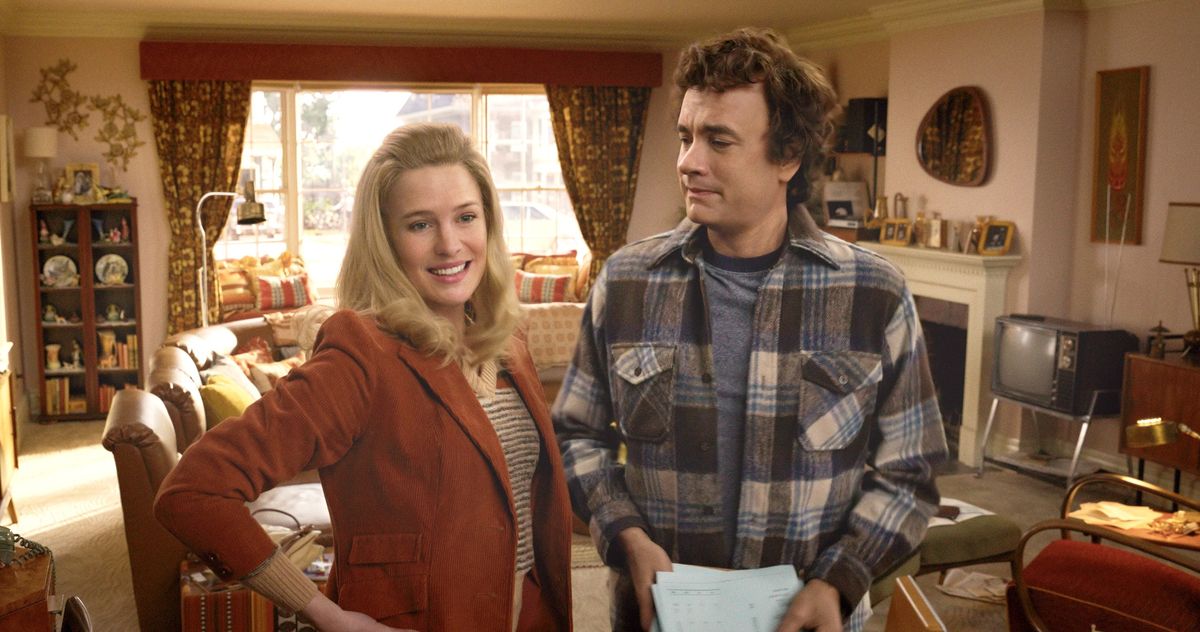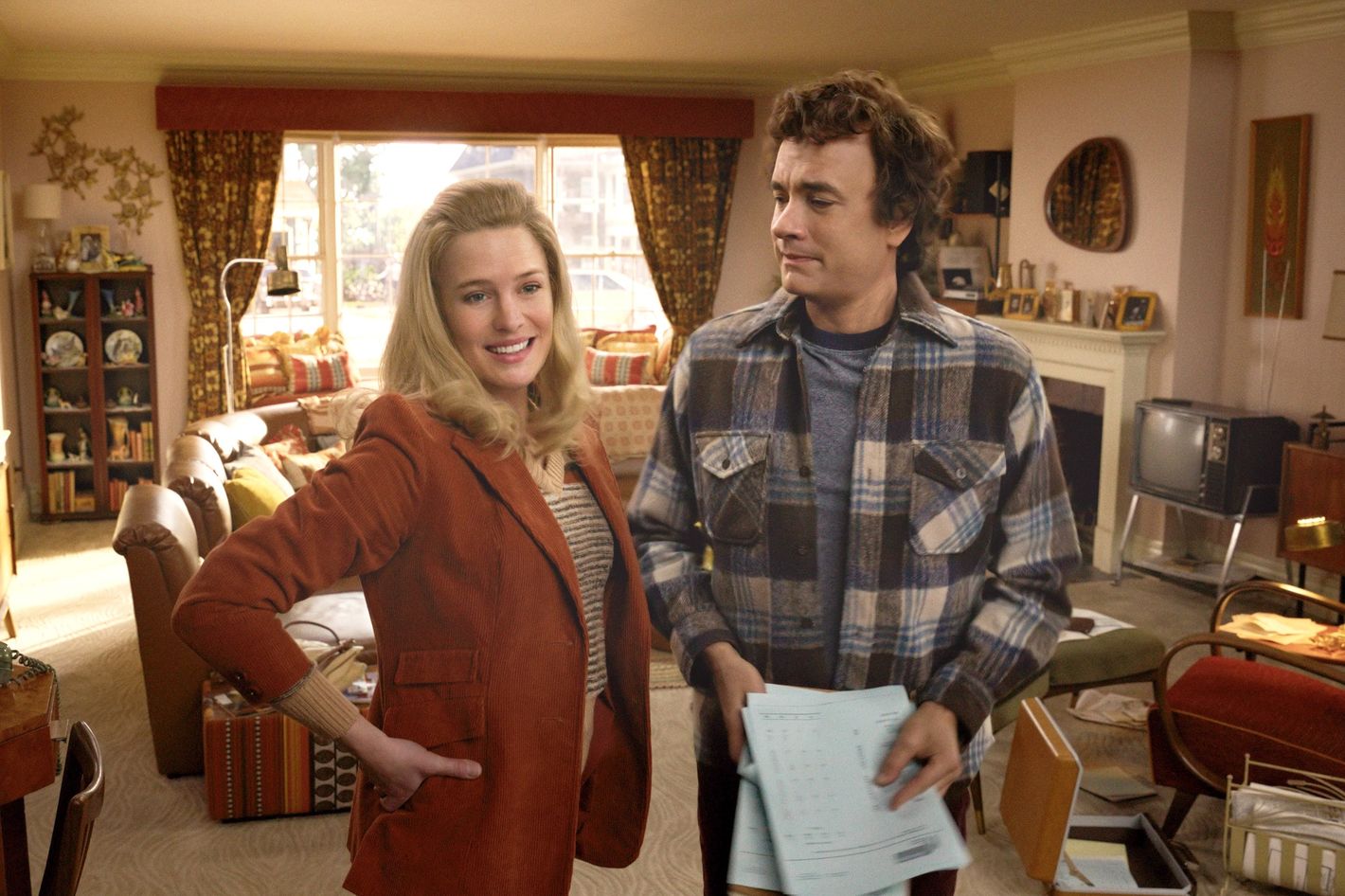Here Is the Biggest Pile of Schmaltz You’ll See This Year
Tom Hanks and Robin Wright reunite for a movie that uses a bold formal device to incredibly hokey ends.


Tom Hanks and Robin Wright star alongside a living room in Here. The movie brings them together onscreen for the first time since Forrest Gump, and there’s something very funny about this reunion playing second fiddle to a Naugahyde sectional. The room is handsome enough, as functional living spaces go, with a bay window facing the historic house across the street and a mantelpiece that serves as the focus until attention is usurped by the arrival of the television. Hanks and Wright are two of the many actors who end up passing through it over the course of the film, which, like the 1994 Best Picture winner, was written by Eric Roth and directed by Robert Zemeckis. The conceit of Here, which was adapted from the comic strip by Richard McGuire, is that time moves while the camera doesn’t, not until it’s released in the final shot. From Here’s chosen angle, we watch generations of residents move in and out and do all sorts of living in between; we only ever see the outside when the film visits a period before the house was built. It’s a bold formal choice to regard the world through a fixed point in space, and, unfortunately, it’s all in service of the biggest pile of schmaltz you’ll see this year.
Whatever you think of Forrest Gump, the fact that Forrest’s life kept intersecting with significant historical incidents was, undeniably, meant as a gimmick. But Here is made up of slices of life, and it still can’t help pinning its characters to major moments in time. The most egregious of these instances comes with the Harrises, the only Black family to live in the house, whose storyline consists entirely of parents (Nikki Amuka-Bird and Nicholas Pinnock) giving their teenage son (Cache Vanderpuye) the talk about police violence and their housekeeper contracting COVID. Every thread, even the central one that takes Richard (Hanks) and Margaret (Wright) from teenagers in the ’60s through to present-day old age, is warped by some version of awkward signposting, as though its characters aren’t living through history so much as they’re containers for it. John Harter (Gwilym Lee) dies in the flu pandemic after years of his wife’s (Michelle Dockery) protests that his love of aviation will kill him. Lee Beekman (David Fynn) spends his days developing a reclining chair while his wife, Stella (Ophelia Lovibond), cheers him on, then it’s sold to a company that decides to market it as (drumroll!) the “La-Z-Boy.” Ben Franklin makes an appearance, as do dinosaurs.
Here clearly wants to offer a prismatic look at a tapestry of human experience. Its best touches, which often involve the use of a stylistic device from McGuire’s comics in which windows open up to other eras, draw parallels as simple as different women cleaning or different couples debating the price of the house over the years. But the film doesn’t trust that the organic stuff of day-to-day existence is interesting enough. Even the main story, which revolves around the disappointments that stunt the lives of increasingly embittered WWII veteran Al (Paul Bettany) and his oldest child, Richard, rests on clumsy cliches about what deferred dreams look like. The father and son are both salesmen in the grand Arthur Miller tradition, with Richard in particular giving up his art-school aspirations when he and his girlfriend, Margaret, get pregnant right out of high school, going instead into life insurance and growing so financially conservative that the couple never buys their own place. They feel not like people but like parts of a fable about suburban stagnation, right down to Margaret decrying that she’s never seen Paris — and they’re the most developed characters that Here has to offer.
Zemeckis is a fallen god of commercial marvels, someone whose late career has been entangled with ventures into dead-eyed performance capture (The Polar Express, Welcome to Marwen) and 3-D (The Walk) that are of interest only to hard-core devotees who see something in the work that I wish I could. Like Ang Lee and, in a different way, Francis Ford Coppola, Zemeckis has become consumed with the promise of technology to advance cinema, all of it perversely put to use on behalf of storytelling that’s haphazard, unengaging, or downright backwards looking. In Here, he uses digital smoothing to age down Hanks and Wright when needed, and their performances barely register under all the tweaking and contortions required to fit their characters’ dramas within the confines of the film’s approach. The results still have something of the uncanny valley to them while looking better than what Martin Scorsese worked with in The Irishman — but it doesn’t really matter when neither actor is capable of moving or conducting themselves in a way that plausibly recreates what it’s like to be that young. I wondered, watching Here, if the reason Zemeckis made it was to play around with de-aging tech, if the central idea was really just an excuse to see what it could do. It would make sense given how much of the movie feels reversed engineered from those capabilities, with all the parts that should matter coming last.








